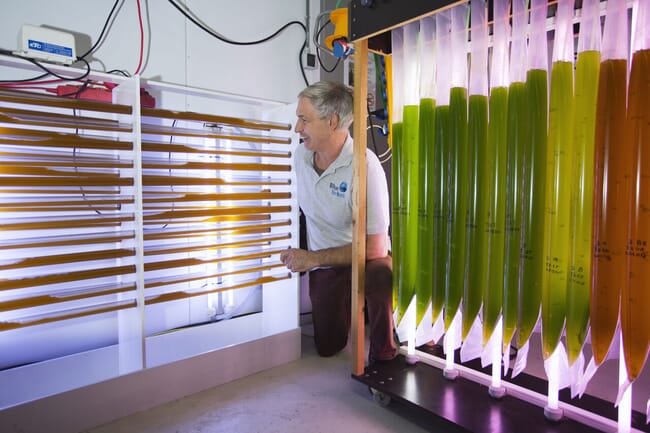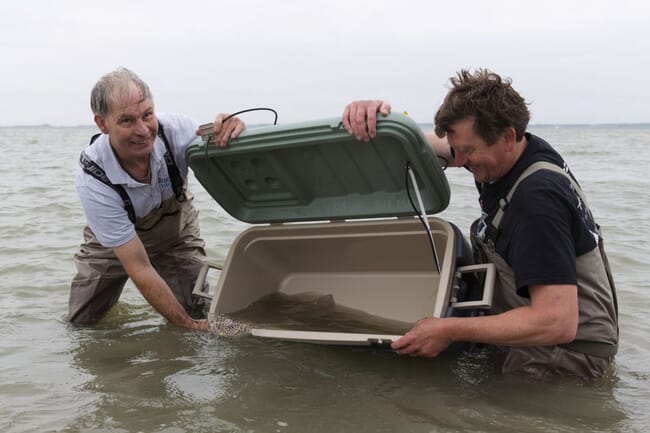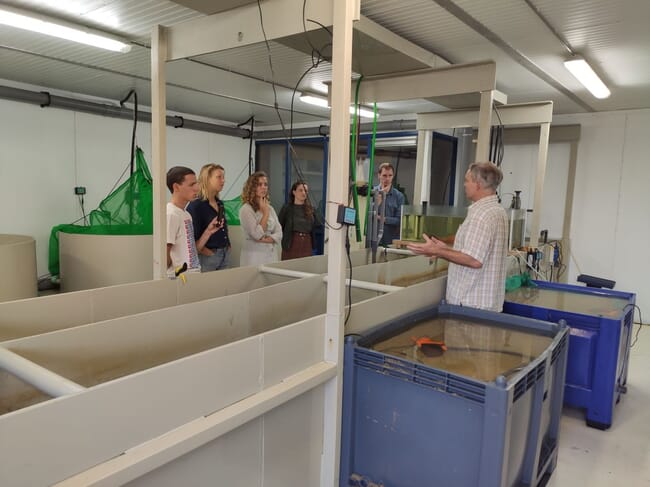
© Bart van Gengeldorp Gastelaars
What drew you to a career in aquaculture?
It started in 1995 when I got a job at Rotterdam Zoo, where I was involved in the construction of the public aquarium, The Oceanium. As a marine biologist, I was commissioned to breed the animals on display in the aquariums. This included a wide variety of species – from jellyfish, corals and nudibranchs to seahorses, cuttlefish, sharks and rays.
During that period, I looked at the working methods in aquaculture and the ways in which organisms develop in nature. As a result I developed new insights into the cultivation of marine organisms.
Why did you decide to move from working in an aquarium to establishing your own aquaculture facility?
With the arrival of a new director the vision and mission of the zoo, and the aquarium in particular, no longer matched my own visions for the future. In 2011 I left the zoo and started my own company, Blue Linked, which allowed me to focus more on conservation projects and the development of sustainable, circular ways to produce marine proteins for a growing world population.
What were the hardest parts of setting up on your own?
I was fortunate enough to be able to join an ongoing project of friends who had received a subsidy to set up a coral farm in the Netherlands. Once the project was completed, I could use the breeding facility to explore my own ideas about alternative ways of producing marine organisms.
During the construction and running of the aquarium in Rotterdam Zoo I had already gained a lot of experience with various life support systems, including the system used in the coral farm. The design, construction and operational aspect were part of my DNA. It also gave me the opportunity to use my biological background to further develop the systems.

© Bart van Engeldorp Gastelaars
Can you describe some of the key projects you’ve undertaken since establishing Blue Linked?
As an expert in the culture and husbandry of corals I was partner in a project that conceptualised and developed a mobile lab for coral culture for the rehabilitation of wild reefs. Fertilisation techniques were carried out in transportable containers, using eggs and sperm obtained from corals off the reef. After fertilisation, the embryos develop into larvae that settle on special substrates in the lab. Each settled larva grows into a new coral colony that can be placed on the reef.
In another project, the coral farm, the aim was to examine the possibility of culturing corals in a sustainable and ecological way for commercial purposes in the Netherlands. In addition, the project offered opportunities for scientific research, concerning the effect of different light conditions on the growth of a range of coral species.
In the same period I started as a pioneer in circular aquaculture. In 2013-2014 we carried out a successful pilot for the culture of turbot fry. In an interim project Blue Linked was involved in the import of tropical marine aquarium animals for less than a year. Although successful, the visions of the commercial partners and Blue Linked were too far apart to continue the cooperation.
Between 2015 and 2020, Blue Linked was the breeding coordinator of a Dutch Government-funded project to investigate whether natural populations of sharks and rays can be strengthened by breeding these fish in large numbers in captivity and then releasing them into the sea. We successfully bred more than 400 stingrays that were released in the North Sea, and some of these stingrays were found inshore in the United Kingdom, Belgium and in the Wadden Sea.
How did you manage to achieve a survival rate of over 80 percent for your turbot?
By turning conventional aquaculture techniques on their heads – instead of looking at the number of larvae you want to raise, you look at the carrying capacity of a system in which you want to raise the larvae. You can then dimension the systems in such a way that they can meet the desired production results.
Where would you like the company to be in 10 years’ time?
My question would not be where I would like to see my company in 10 years' time, but where I would like to see the production of our food in relation to the carrying capacity of our planet.
A food transition is needed if we, as a growing world population, want to continue to live in harmony with our planet. I would like to contribute to this food transition and I would like Blue Linked to be able to act as a role model with a circular breeding system in aquaculture.
Blue Linked's culture system offers unique opportunities – both for the sustainable culture of fish for consumption and for enhancing fish populations in the wild – creating a model under the motto “one fish on your plate and one fish in the sea”. This concept has been taken up by the Knowledge and Innovation Agenda 2020-2023 of the Dutch Government.
What’s your proudest achievement to date?
In terms of outputs, the development of the mobile laboratory for coral reef recovery and the successful breeding of sharks and rays, including the release of thornback rays with the WWF, are the most important milestones. But I am most proud of the fact that after all these years, without subsidies and support from the sector, we are still striving for a more sustainable and circular approach in aquaculture and that I have been able to educate and inspire a new generation of young professionals. The new stewards of the planet.

If you could achieve one more thing in aquaculture, what would it be?
Demonstrate that the principle of circular fish farming works and that commercial fish farming is compatible with nature conservation objectives and can be applied throughout the world. That the principle of circular fish farming is more widely accepted in the marine aquaculture sector and that the sector embraces more values than just a commercial result.
How do you see the aquaculture sector developing over the coming years?
When I look at current developments in the aquaculture sector, I do so with some concern. Current developments are mainly driven by commercial interests and are aimed at maximising production, with a focus on only a few locations. However, driven by society's need for a more holistic production model, animal welfare, sustainability and socio-economic aspects will gain in importance. If the aquaculture sector replaces the wait-and-see attitude with a progressive attitude and invests more in the factors mentioned, the industry will play a long-lasting prominent and exemplary role in the upcoming food transition. I would like to invite every individual or organisation that is willing to contribute to this transition to reach out to me to explore how we can realise this together.
What advice would you give to anyone looking to start a career in aquaculture?
If you want a career in aquaculture, do so out of passion. Don't look at what the aquaculture sector can do for you, but what you can do for the aquaculture sector, out of interest for the people and the planet. With the right attitude you can build up a life-long, varied career, where appreciation will come from unexpected corners.


